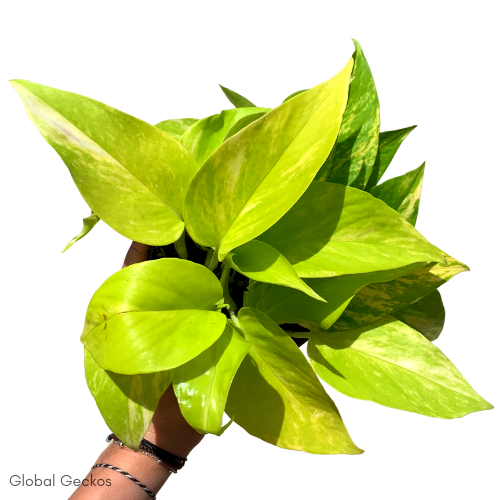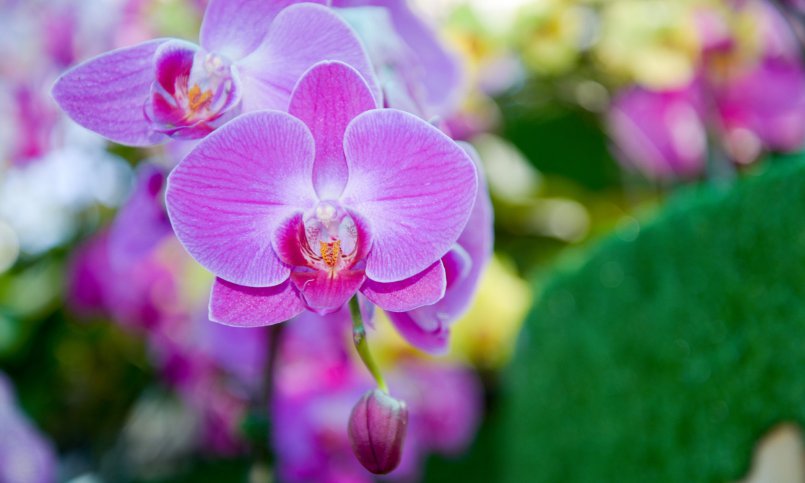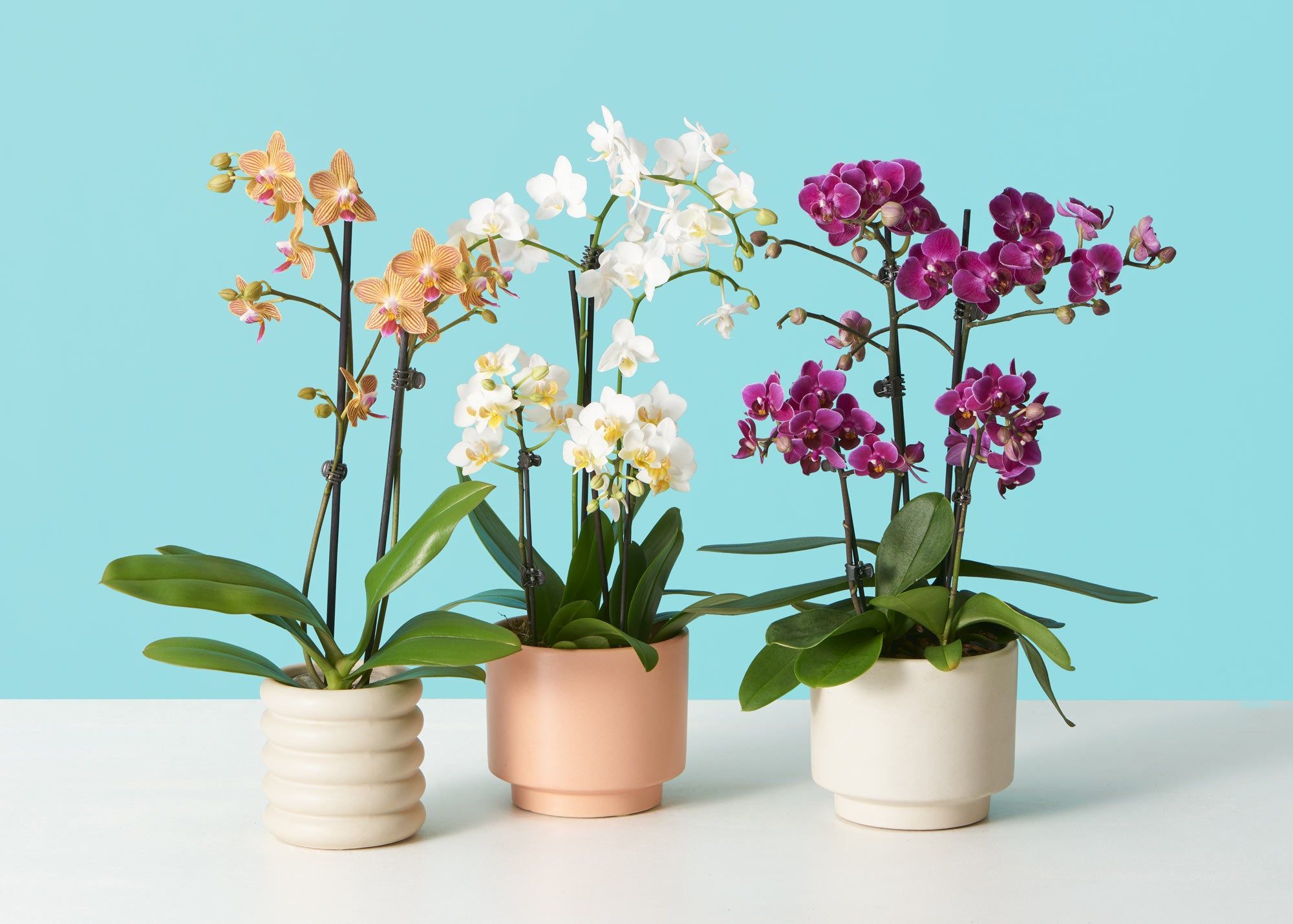Choosing plants for a north facing window can be challenging for indoor gardeners. Not all houseplants can cope with the lower light conditions of a room that receives no direct sunlight, so your choice of plants is crucial. Thankfully, there are some wonderful options for north facing window plants, that can thrive and bring beauty to your home.
This list covers some excellent plants that are suitable for the lower light conditions of a north facing room. Some of my all time favorite indoor plants are included on this list. Whether you’re looking for an easy starter plant or an ornate tropical wonder, there are plenty of plants just waiting to call your windowsill home.
1. Epipremnum Aureum (Golden Pothos)

Pothos plants are often mistaken for philodendrons. Both of these plants are easy to care for; the main difference is that the Pothos has large, dark green leaves with a yellow or white pattern.
Golden Pothos is also sometimes called “devil’s ivy;” this name references how hard the plant is to kill. As a houseplant, the hardy nature of the Pothos makes it a great low-maintenance choice that can thrive in almost any set of conditions.
- Pros: Easy to care for. Loves shady areas, but handles indirect light well.
- Cons: Requires pruning to keep vines from overgrowing the container.
- Care Requirements: Keep warm. Prefers high humidity, but will tolerate most conditions. Let soil dry between waterings.
2. Sansevieria Trifasciata (Snake Plant)

Snake plants are one of the most popular low-light houseplants. These hardy jungle plants are loved for their spiky leaves and incredible resilience.
Snake plants do best when given access to bright, indirect light. Lower light conditions won’t harm your Sansevieria, but it may slow the speed of overall growth. Snake plants thrive on neglect, and hate to be overwatered, so take it easy with the watering can.

- Pros: Easy to maintain and tolerates neglect very well. Snake plants come in a wide variety of sizes and leaf patterns.
- Cons: Reacts poorly to cold temperatures. Toxic to pets. Does not tolerate overwatering.
- Care Requirements: Does well in most levels of humidity. Water once the soil is almost completely dry and fertilize monthly during the growing season. Move away from the window during the winter.
I’ve written quite a few articles on snake plants on this site, including my guide to snake plant care, as well as articles covering the common problems, and why snake plants get brown tips, drooping or curling leaves.
3. Spathiphyllum Wallisii (Peace Lily)
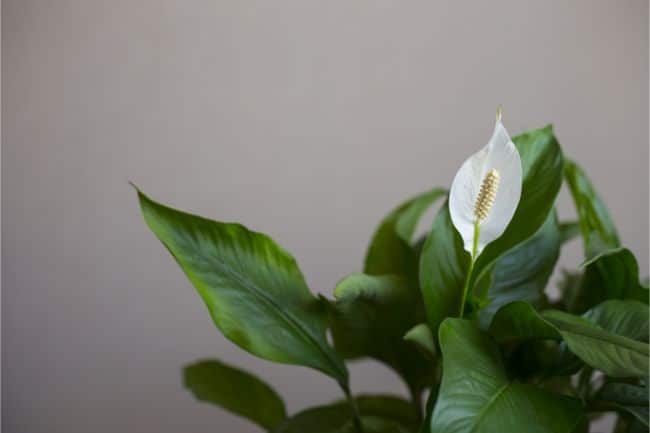
If you’re looking for a flowering plant that doesn’t need too much sunlight, a peace lily is an excellent choice. These beautiful plants are known for their attractive foliage and striking white blooms.
Peace lilies tend to grow slowly. Young plants may only produce one bloom at a time; luckily, they keep flowering throughout the year. Peace lilies are generally easy to care for, and will they will tell you when they are in need of water by drooping dramatically.
- Pros: Does well with indirect sunlight. Produces flowers throughout the year.
- Cons: Will produce fewer or no blooms in lower light conditions. Toxic to pets.
- Care Requirements: Prefers mild humidity and average temperatures. Keep soil moist. Divide and prune often to keep the plant blooming as it matures.
Read all about how to care for Peace Lilies, including how to prevent and fix the common problems in this article.
4. Phalaenopsis (Moth Orchid)

Phalaenopsis orchids are gorgeous plants with blooms that come in a wide variety of colors. They do best with access to bright yet indirect sunlight, making them excellent north facing window plants.
Phalaenopsis orchids are one of the most stunning indoor plants, with their delicate and long-lasting blooms. They are my all-time favorite houseplant, and my home is filled with them. Phalaenopsis orchids thrive in lower light conditions, where many other flowering indoor plants will struggle.
- Pros: Fairly easy to care for. Produces beautiful blooms that last for many months at a time. Will rebloom year after year if cared for correctly.
- Cons: Root rot is common, but easily avoided if you use the right potting medium and check your plant before watering every time.
- Care Requirements: Water infrequently; let the potting media dry out between watering. Prefers average to warm temperatures. Fertilize with a very dilute water soluble fertilizer on a 1-2 weekly basis throughout the growing months.
This site is full of articles about orchids, particularly phalaenopsis orchids. Read my phalaenopsis orchid care guide here, or get my free phalaenopsis orchid ebook here.
5. Aglaonema Modestum (Chinese Evergreen)

Chinese evergreens feature wide, flat leaves with dappled patterns across their surface. Many different patterns are available; look for tiny speckles, large blotches, and crosses between the two.
Aglaonema plants do well in low light, but they still need some indirect sunlight to thrive. The darker the leaves of the plant, the better it will do in shady conditions. A mature Aglaonema may produce tiny flowers between the leaves.
- Pros: Features large, decorative leaves. Many patterns are available.
- Cons: Plant must be kept warm; temperatures below 60 degrees can cause leaves to brown. Toxic to pets.
- Care Requirements: Prefers humid environments. Keep soil moist. Move away from windows in the winter.
6. Calathea Ornata (Pinstripe Calathea)

Calathea ornata plants love humid, shady conditions that mimic their natural rainforest environment. Often known as the pinstripe calathea for their stunning leaves, these gorgeous houseplants are well worth the extra effort that they require.

Calatheas are rather sensitive plants. They require humid conditions, consistent watering, and the perfect amount of indirect light. Luckily, Calatheas are also expressive; the leaves will curl if something is wrong with their environment, and they will uncurl when positive conditions are restored.
- Pros: Foliage is stunningly beautiful. Leaves turn throughout the day to chase the sun.
- Cons: Sensitive to watering and humidity levels ; develop a consistent watering routine and monitor humidity.
- Care Requirements: Provide a warm and humid environment and maintain moist, but not soggy potting soil. Avoid drafts of hot or cold air.
Read more about Calathea ornata in my care guide, which covers everything you need to know to grow healthy and beautiful pinstripe calatheas.
7. Aspidistra Elatior (Cast Iron Plant)
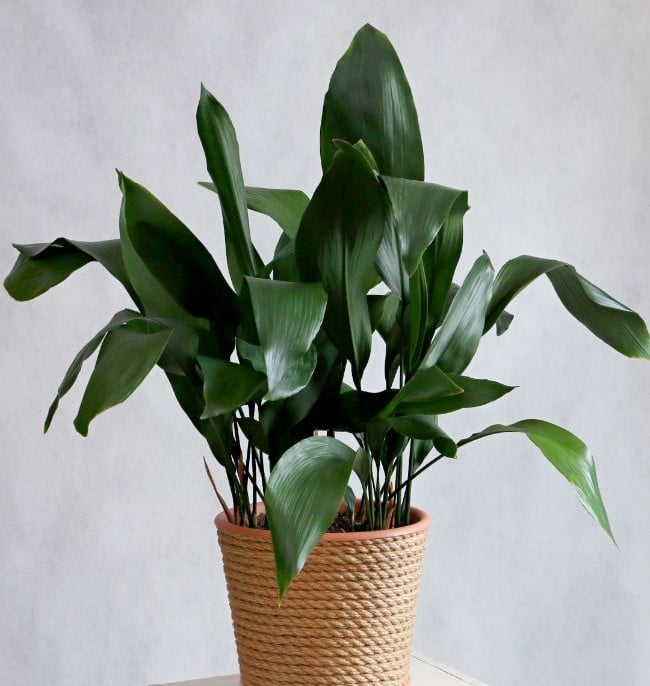
Cast-iron plants are some of the most durable houseplants on the market. Also known as ballroom plants, Aspidistras feature thick, dark green foliage that arches elegantly outwards.
Aspidistras do best with a significant amount of shade. The indirect light from a shady north-facing window will be more than enough. Cast-iron plants can survive in nearly any temperature or humidity, and they’ll even forgive you if you forget to water them once in a while.
- Pros: Extremely durable and easy to care for. Will tolerate being neglected for an extended period of time. Loves shade.
- Cons: Grows rather slowly.
- Care Requirements: Provide well draining soil and indirect light. Fertilize monthly during the growing season with half strength water soluble fertilizer. Let the top two thirds of the potting mix dry out before watering. Read everything you need to know about cast iron plants in this article.
8. Bromeliacea (Bromeliads)
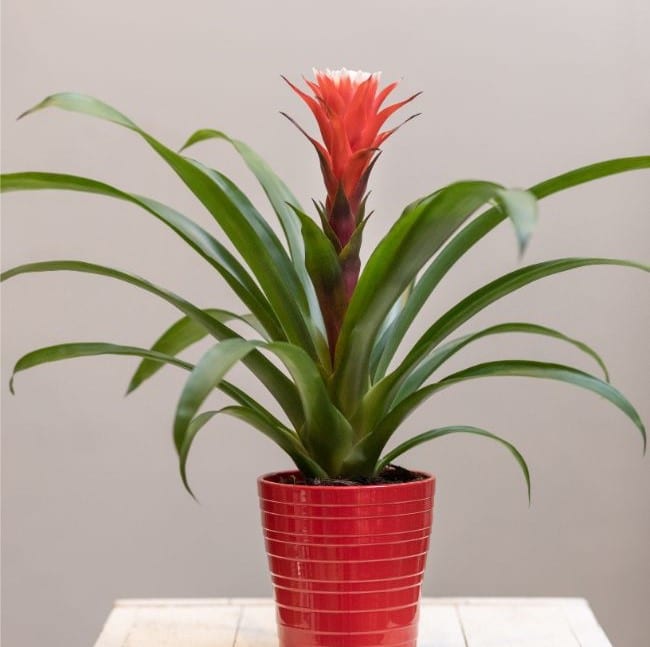
There are over three thousand species of bromeliad and nearly all of which do well in low-light conditions. The plants all feature spiky leaves that extend from the center of the plant; pineapples are actually a species of bromeliad. Many different colors, patterns, and types of foliage are available.
In general, bromeliads with darker colors tend to make better north facing window plants. Look for a variety that comes from the rainforest; Bromeliaceae Guzmania and Bromeliaceae Aechmea are both excellent choices.
9. Chamaedorea Elegans (Parlor Palm)
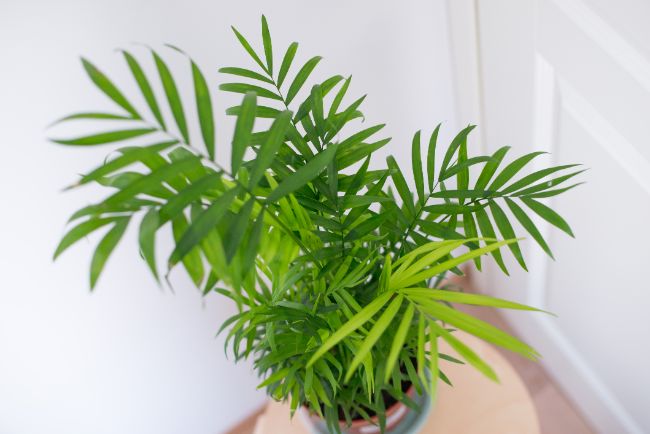
Parlor palms have soft leaves and thin stems. They tend to grow in clusters, creating the appearance of a single, shrub-like plant. These indoor palms love indirect sunlight and are an attractive option that is just as suitable as a small windowsill plant, or a much larger floor plant.
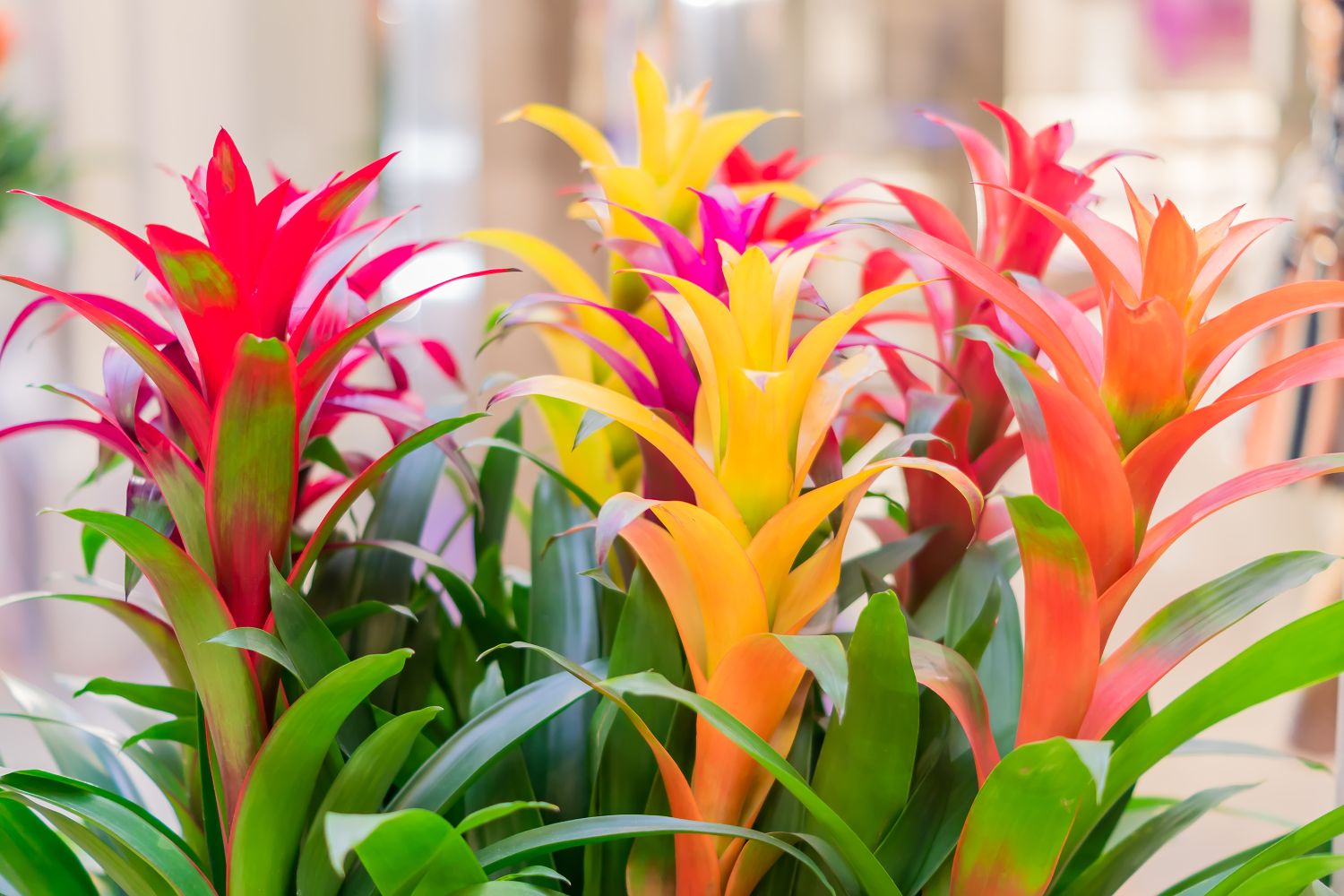

When treated well, a parlor palm can get up to six feet tall. Be careful repotting these plants, as their roots are very fragile. In some circumstances, your parlor palm may produce small yellow flowers.
- Pros: Beautiful foliage. Non-toxic.
- Cons: Easy to overwater; let soil dry out before watering again.
- Care Requirements: Prefers average temperatures and humidity. Avoid cold drafts. Water carefully. Fertilize rarely.
I’ve covered all the care requirements and pros and cons of Parlor Palms in this article.
10. Philodendron Scandens (Heart-Leaf Philodendron)
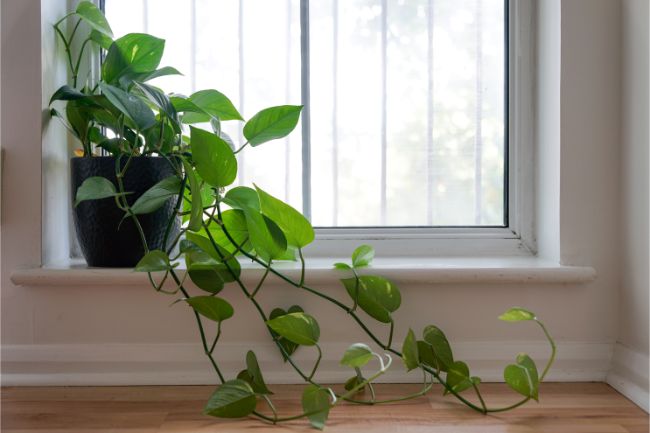
Philodendrons are well known as excellent starter houseplants; they don’t require much maintenance, and they react well to environmental changes. Most species in the Philodendron genus thrive in low light or partial shade.
Heartleaf philodendrons, named for their smooth and instantly-recognizable leaves, are perfect north facing window plants. These plants prefer indirect sunlight and scorch easily under direct rays.
- Pros: Easy to care for. Can be trained to climb along a trellis. Mature plants may produce white flowers.
- Cons: Sensitive to direct sunlight and overwatering.
- Care Requirements: Thrives in average temperatures and mild humidity. Avoid overwatering.
11. Monstera Deliciosa (Swiss Cheese Plant)
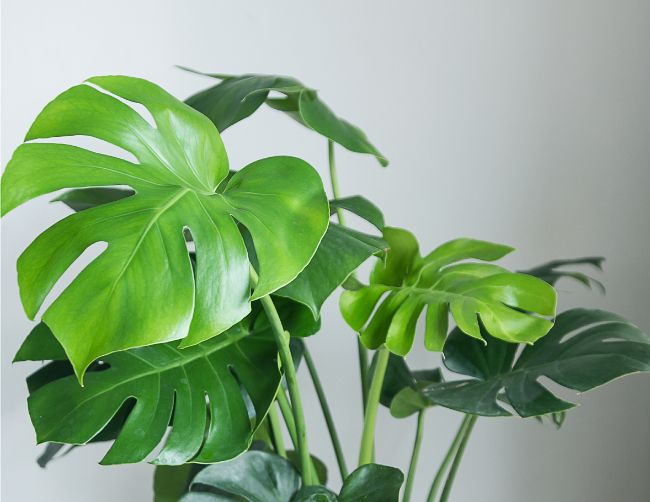
Despite the name, Monstera plants are surprisingly easy to care for. Monsteras are tropical plants, but they do well in most home environments. These plants grow best in a bright room with indirect sunlight. If provided a support trellis, Monsteras can grow to be exceptionally tall.
Monsteras are also called “swiss cheese plants.” This name refers to the small slits that develop naturally on a Monstera’s leaves. These slits won’t show up until the plant is mature; before then, the leaves are small and heart-shaped.
- Pros: Easy to care for. An excellent choice of large indoor plant for lower light conditions.
- Cons: Requires support structures. Needs pruning to maintain desired size.
- Care Requirements: Provide nutrient rich, well draining soil, indirect light and water once the top two inches of soil is dry. Fertilize monthly when actively growing and provide average to high humidity.
Learn everything you could ever wish to know about Monstera deliciosa in my comprehensive article.
12. Adiantum (Maidenhair Fern)
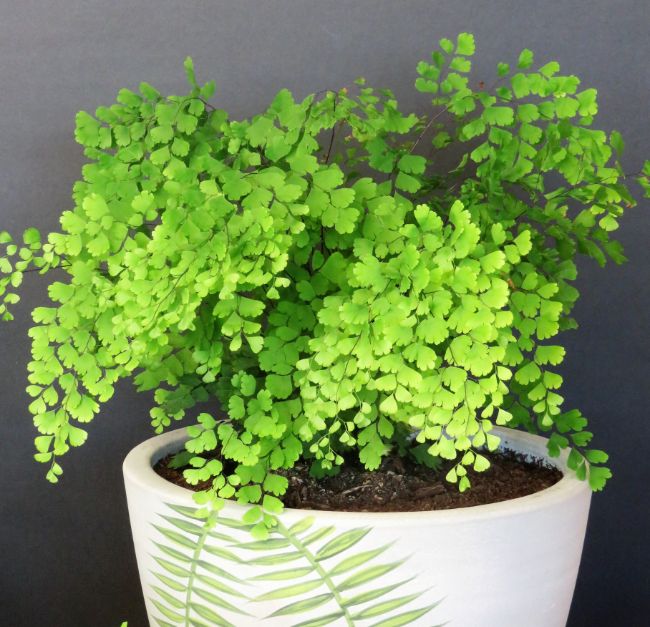
Maidenhair ferns have soft, gentle fronds that spread out from the base of the plant. Adiantum plants are native to North America, and the oil that they produce is occasionally used in shampoos and other cosmetics. Although these plants prefer to grow in shady gardens, they do quite well as indoor houseplants.
:max_bytes(150000):strip_icc()/grow-adiantum-ferns-1902722-10-4e79074809694fa8bea32a562b1eb28a.jpg)
Adiantums aren’t as easy to care for as many of the plants on this list, but they are one of the easier indoor ferns to keep in good health. I love the delicate and beautiful foliage of Maidenhair ferns which bring the feel of a tranquil forest indoors.
- Pros: One of the easier to care for indoor ferns. Pleasant scent from the fronds and very attractive foliage. Can do really well in a closed terrarium.
- Cons: Requires continually moist soil and high humidity to do well. Does not like repotting.
- Care Requirements: Prefers moderate temperatures, high humidity and continually moist soil. Do not let soil dry out completely. Avoid direct sunlight.
Read up on exactly how to keep a Maidenhair fern in good health in this article.
13. Pilea Cadierei (Aluminum Plant)
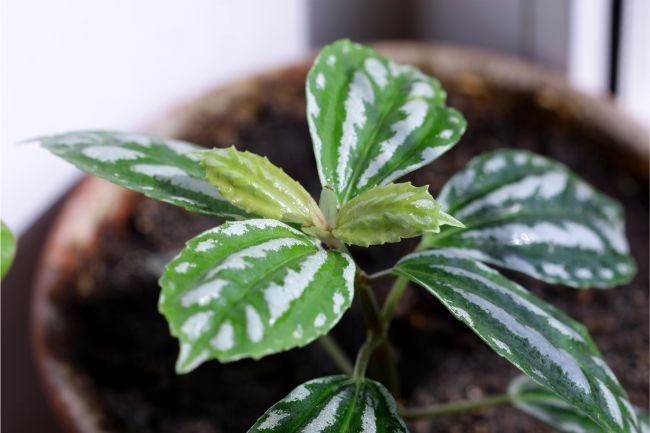
The “aluminum plant” is named for the bright silver patterns that adorn its green leaves. The metallic stripes contrast really nicely with the vibrant green of the rest of the leaves, making this a very attractive plant.
Pileas are tropical plants that love warm and humid conditions. Native to forest floors, they thrive in indirect light, so are perfect north facing window plants. They tend to be quite fast growing, and spread outwards quite quickly, so require consistent pruning to keep the plant at the desired size.
- Pros: Easy to care for. Unique and beautiful leaf patterns.
- Cons: High humidity requirements. Fast growth requires pruning as needed.
- Care Requirements: Prefers humid environments. Keep warm, and avoid drafts. Water after soil is dry. Pinch flowers to promote foliage. If you’d like to learn more, read Aluminum Plant care article.
14. Fittonia (Nerve Plant)

Fittonias have dark green leaves covered in beautifully colored veins. Some fittonias have silver veins, but pink, green, and white varieties are also available. These intricate patterns give the plant a distinctive appearance and have led to its nickname of the “nerve plant.”
Compared to other low-light plants, fittonias can be temperamental and picky with their environment. A fittonia grows best in a hot and humid room with a mix of indirect sunlight and partial shade. They require a high level of moisture that can lead to root rot if not managed carefully.
Although a little tricky to care for at times, it doesn’t stop me from loving them. The foliage is just so beautiful with those delicate patterns. One sure fire way to keep a nerve plant happy is to put it in a closed terrarium, where it will love the warm, moist and humid conditions.
- Pros: Very satisfying to keep healthy and vibrant. Intricate and beautiful leaf pattern.
- Cons: Requires frequent watering and high humidity.
- Care Requirements: Keep warm, ensure high humidity, water regularly, and use a well-draining soil. Read my nerve plant care guide here.
15. Ctenanthe (Never-Never Plant)
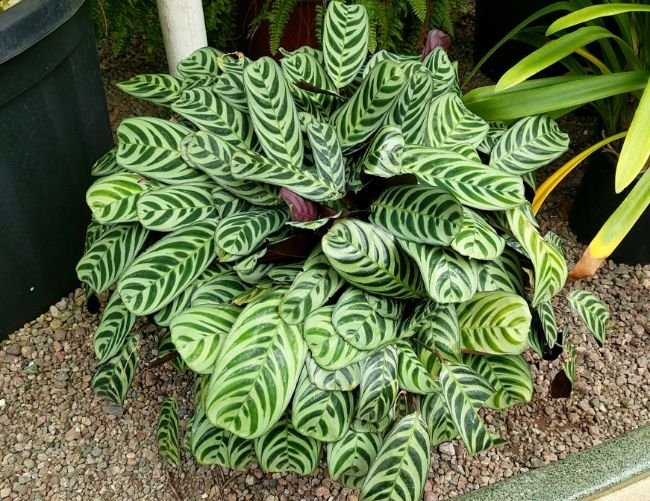
The Ctenanthe is a gorgeous tropical plant that grows low to the ground. Never-never plants feature large leaves with deep markings that vary based on the species. The leaves are usually light or dark green, while the stems and the undersides of the leaves are often a deep purple color.
Compared to other tropical plants, Ctenanthes are hardy and resilient. Although they don’t like cold or dry conditions, Ctenanthes can tolerate the occasional drop in temperature without lasting issues. These plants do best in warm and humid environments with access to bright indirect light.
- Pros: Resilient and easy to care for. Many patterns available.
- Cons: Needs humidity to thrive. Toxic to pets.
- Care Requirements: Requires a warm and humid environment. Keep soil moist. Provide bright but indirect light. May be kept on the porch during the summer. Learn everything required to keep a ctenanthe plant healthy in this article.
16. Nephrolepis Exaltata (Boston Fern)
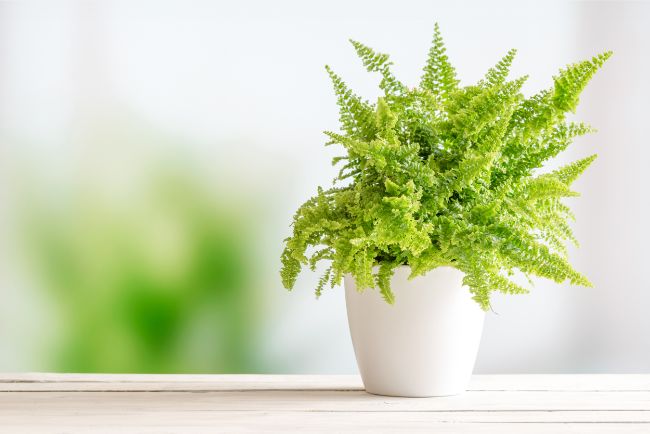
The Boston fern, also known as the sword fern, has broad and vibrant fronds that jut out cheerfully from the base of the plant. These ferns aren’t actually from Boston – they’re typically found in warm, humid regions like Florida.
Boston ferns love bright but indirect light. You’ll usually see these plants in hanging baskets or at the center of a decorative container. Like other tropical plants, Boston ferns need plenty of humidity and a warm climate to survive.
- Pros: Easy to care for. Highly decorative leaves.
- Cons: Does not tolerate cold or drafts.
- Care Requirements: Prefers average temperatures and high humidity. Needs access to indirect light. Keep soil moist. Fertilize occasionally.
17. Chlorophytum Comosum (Spider Plant)
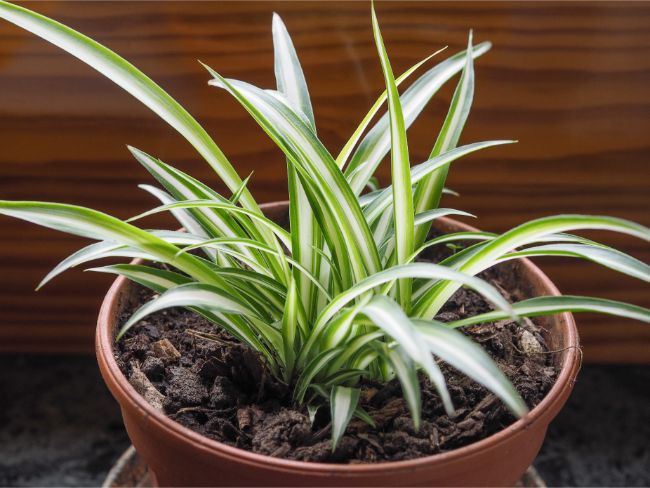
Spider plants are extremely easy to care for and tolerate nearly any set of conditions. These leafy plants do very well with low amounts of light and love being placed near north-facing windows. The older your spider plant gets, the more dramatic its leaves will be.
Although spider plants are drought-friendly, they still do best when watered on a consistent schedule. Increase humidity to prevent brown tips on the leaves, especially if you live in a dry climate.
- Pros: Easy to care for. Tolerates most light levels.
- Cons: Prone to brown tips on the leaves and won’t tolerate overwatering.
- Care Requirements: Prefers bright indirect sunlight; will scorch under direct sunlight if not acclimatized. Use a quick-draining soil. Do not overwater.
18. Hedera Helix (English Ivy)
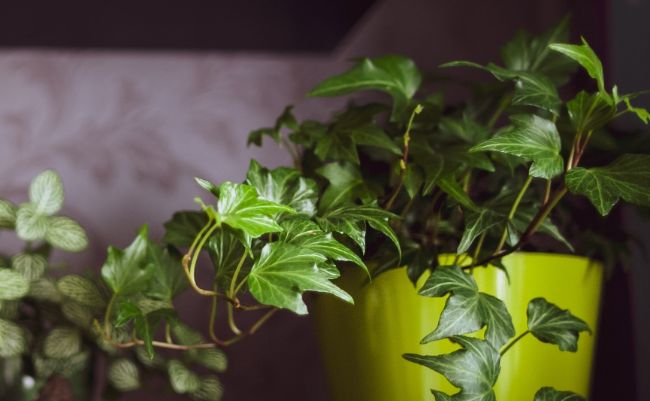
When it grows in the wild, English ivy is often thought to be a pest. However, these hardy plants do well in low-light conditions, making them great north facing window plants, with their beautiful, star-like leaves.
English ivy is a vine plant that prefers a trellis or a support structure. Interestingly, English ivy actually prefers cool environments over warm ones; it might be a good choice if you prefer to keep your home at around 60-65 degrees. English ivy dries out quickly and may need supplemental humidity in more arid climates.
- Pros: Loves shady and cool environments. An excellent choice of climbing plant for indoors.
- Cons: Dries out easily. Needs pruning.
- Care Requirements: Provide a humid environment with cool to moderate temperatures. Keep soil moist. Prune and train into desired shape.
19. Dracaena Sanderiana (Lucky Bamboo)
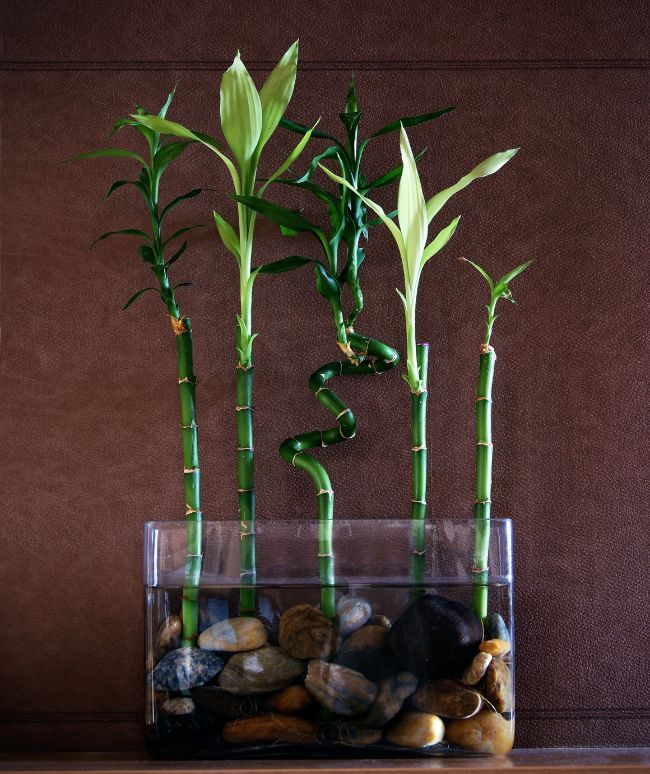
There are many types of dracaena, including the popular lucky bamboo (pictured above). This interesting plant can either be grown in soil or even in water. Lucky bamboo love bright, filtered light, but they scorch under direct sunlight. If you have a large north-facing window, this is a stunning decorative choice.
Available in a variety of sizes, lucky bamboo can be made to suit any shady spot in your home. These plants can be shaped as they grow, pruned easily and are often arranged in very decorative displays.
- Pros: Interesting and striking foliage shapes. Resilient to pests.
- Cons: Sensitive to the type of water used, particularly if high in fluoride, chlorine or if high in dissolved minerals. Toxic to pets.
- Care Requirements: Keep in a warm and humid environment. Can be grown in water or soil. Filter light to prevent scorching.
20. Begonia Rex (Painted-Leaf Begonia)
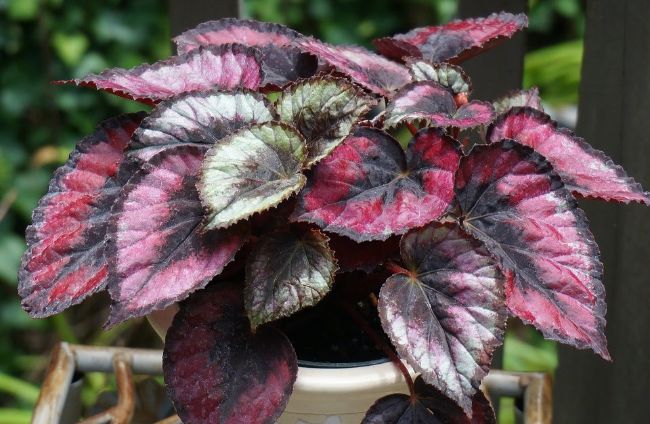
Begonias are cultivated for both their flowers and their foliage. Flowering begonias don’t do well in low light, but the Rex begonia actually thrives in these shady conditions.
There are many different varieties of Rex begonia available, all with unique colors and leaf patterns. These plants are easy to care for and do well indoors. Rex begonias prefer warm and moderately humid environments.
- Pros: Easy to care for. Many varieties available.
- Cons: Unlikely to flower without access to bright light.
- Care Requirements: Provide plenty of indirect sunlight. Keep environment warm and slightly humid. Do not overwater. Read all about how to care for Rex Begonias here.
21. Zamioculcas Zamiifolia (ZZ Plant)
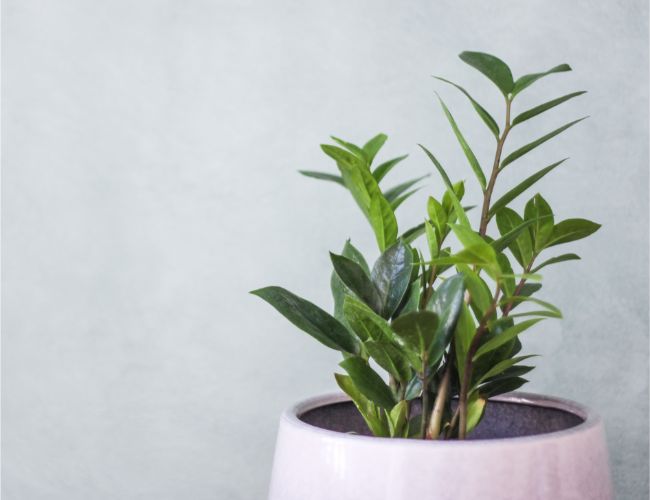
The ZZ plant is a succulent that grows extremely well in low-light conditions, making it one of the best north facing window plants you can choose. In fact, these hardy plants are often recommended for windowless rooms. ZZ plants grow slowly, but if given time, they can reach up to three feet in height.
ZZ plants do well in a range of temperatures and humidity levels, so they’re a good choice for environments that are difficult to control. These plants spring back easily from temperature changes or forgotten waterings.
- Pros: Easy to care for. Thrives in most environments.
- Cons: Toxic to pets. May irritate skin if handled or when pruning. Although notoriously resilient to neglect, they will struggle if overwatered.
- Care Requirements: Prefers average temperatures and humidity. Do not overwater. Repot yearly while the plant is growing. Prune occasionally.
I hope this article has helped you find the perfect north facing window plant. Thinking about the conditions of your room before you choose a plant is so important to make sure your plant continues to thrive in your home.
If you need a plant for the other side of your house, check out this list of plants suitable for hot rooms and south facing windows.



